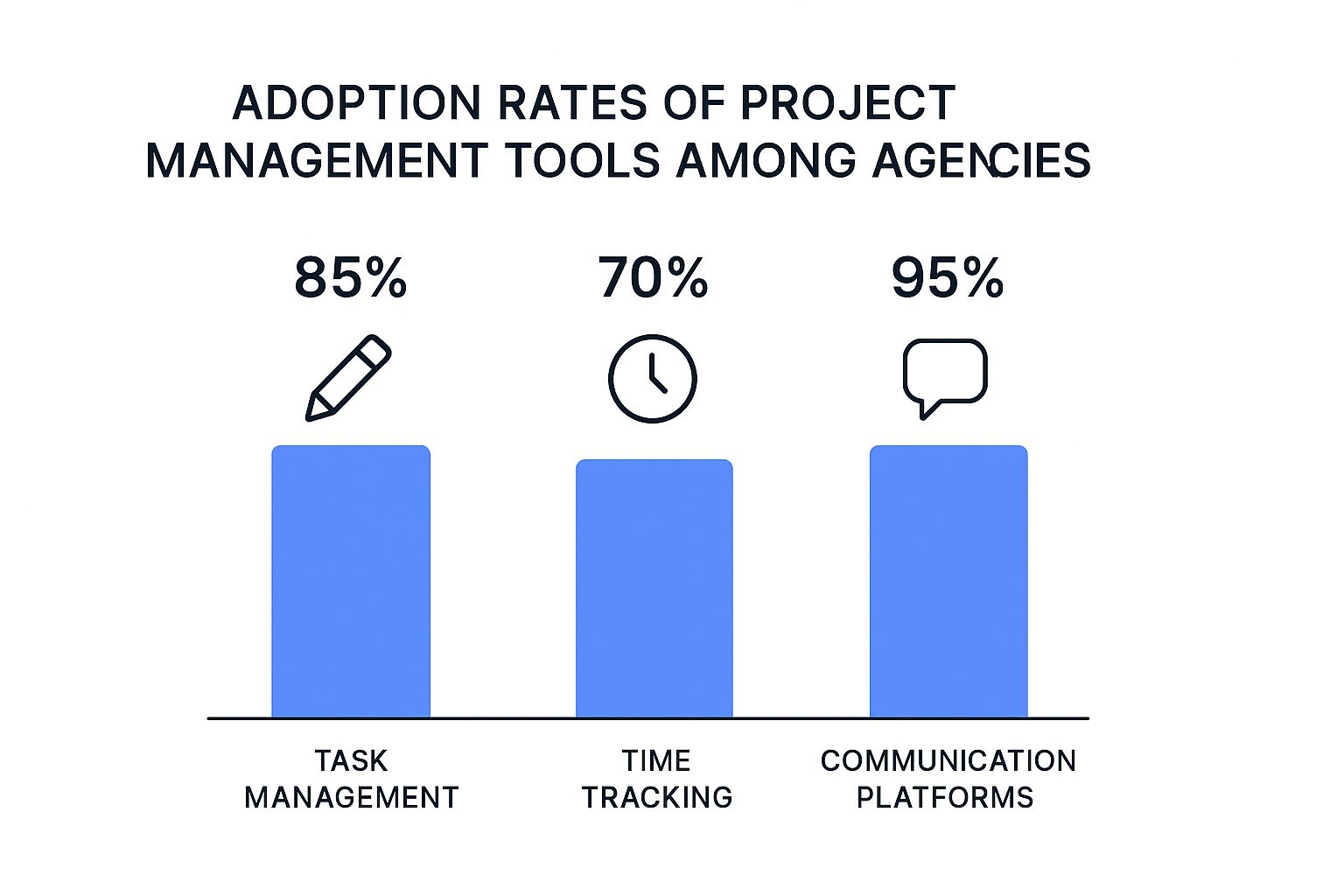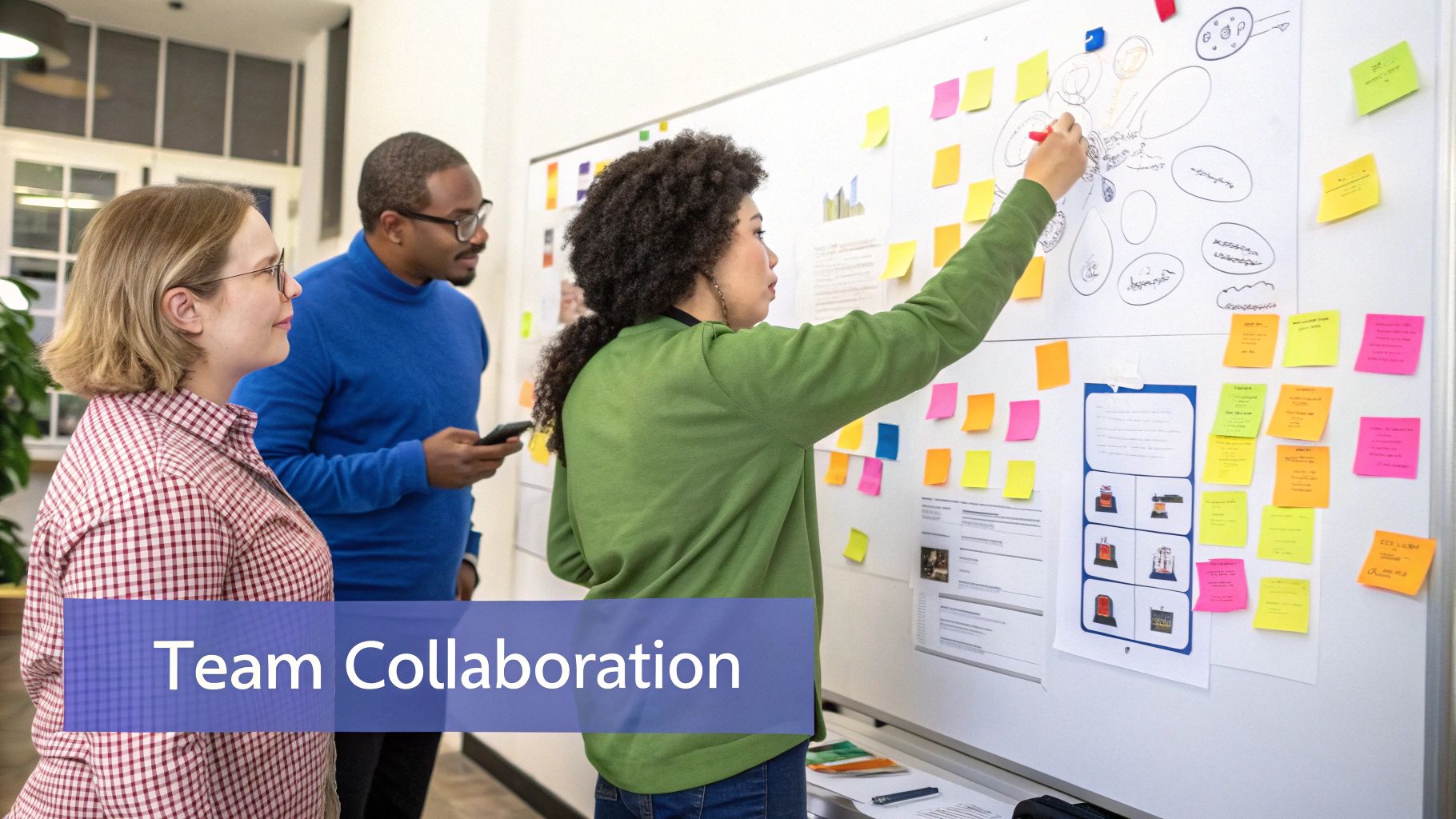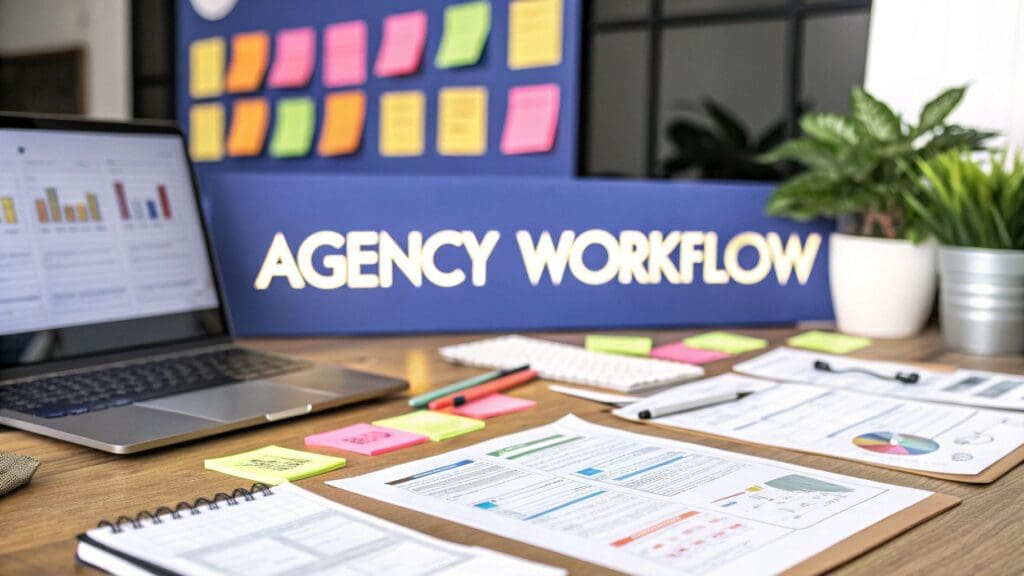Project management in a creative agency is a different beast altogether. It's the art of corralling the beautiful chaos of creative work within the hard lines of budgets and deadlines. The real magic is building a system that organises that chaos without killing the creative spark.
Success hinges on structure that empowers-not restricts-creativity.

Why Agency Project Management Is Different
Trying to manage projects in a creative agency the same way you would in a corporate IT department is a recipe for disaster. The fast-paced, often unpredictable world of agency work means that rigid, traditional methods simply don't fit. They create friction, frustration, and ultimately, stifle the very work you're trying to produce.
The core challenge is finding a delicate balance. You're constantly juggling client expectations, shifting priorities, and the relentless pressure to deliver groundbreaking work on time and on budget. Unlike a manufacturing line, creative work is rarely a straight path from A to B.
The Unique Pressures on Agencies
Agencies live and breathe a distinct set of pressures that directly shape how they need to manage projects. If you don't account for these, your system is doomed from the start.
- Client Collaboration and Feedback: Projects are a constant conversation. Client feedback and last-minute revisions can completely change a project's direction at any moment. Your process needs to absorb this, not fight it.
- Balancing Multiple Projects: It's rare for a team to be working on just one thing. They're usually spinning multiple plates for different clients, each with its own timeline, budget, and stakeholders.
- Protecting Creative Energy: A great project manager acts as a shield. They protect the creative team from administrative noise and conflicting requests, freeing them up to focus on what they do best: creating brilliant work.
The goal is to build a system that drives profitability, improves client relationships, and protects your team's creative energy. It transforms project management from an administrative task into a strategic asset.
Navigating these challenges means looking for practical, real-world solutions. It’s useful to draw on proven small business project management tips for real results, as they often address the same pressures agency owners and their teams face daily.
This isn't just a hunch; the industry data backs it up. In the UK agency world, there's a growing recognition that solid project management is a key driver of success. In fact, over 80% of project managers in the UK see project portfolio management as vital for aligning their work with core business goals.
Choosing Your Agency's Project Management Framework
Picking a project management framework is about more than just choosing a tool; it's about setting the entire rhythm for your agency. It dictates how your team talks, collaborates, and ultimately, how they get work out the door. The right one brings clarity to the creative chaos. The wrong one just adds friction.
Think of it like setting up a professional kitchen. Are you a high-end restaurant with a rigid, step-by-step process for every dish? Or are you a fast-paced food truck that has to adapt its menu on the fly based on what's fresh? Neither is wrong, but one is definitely a better fit for your specific business. The same logic applies to project management for agencies.
Before we get into specific methods, it's worth looking at what tools agencies are actually using.
The data below shows what kind of project management tools agencies are adopting.

It's no surprise that communication platforms are almost universal. But task management systems are right behind, showing a clear need for both seamless collaboration and structured work.
The Waterfall Model: Predictability vs. Flexibility
The Waterfall model is the classic, linear approach. Imagine building a house-you pour the foundation, then you build the frame, then you put on the roof. You can't put the roof on before the frame is up. Each phase is completed in a strict sequence.
- Requirements: Everything the client wants is defined upfront.
- Design: The full solution is designed based on those fixed requirements.
- Implementation: The team gets to work and builds the thing.
- Testing: The finished product is checked for bugs and issues.
- Delivery: The project is handed over to the client. Done.
For an agency, Waterfall offers one huge benefit: predictability. Clients know what they’re getting and when. It works well for projects with a very clear, fixed scope, like building a simple website from an existing template where you know there won't be any surprises.
But its rigidity is also its biggest weakness in a creative setting. What happens when the client has a brilliant idea halfway through the design phase? With Waterfall, you can't just slot it in. Making that change is often difficult and expensive, sometimes forcing you to go all the way back to the start.
The Agile Approach: Embracing Change
In complete contrast, Agile is like that food truck kitchen we talked about. Instead of mapping out a five-course meal from start to finish, the team works in short, focused bursts called sprints. They might perfect the appetiser in the first week, get feedback, and then move on to the main course.
This iterative process is built to embrace change. It accepts that in creative work, the best ideas often emerge during the project, not just at the start. While many agencies love this flexibility, it's no magic wand. Even with this adaptable model, a surprising 47% of Agile projects still run into issues like delays or going over budget. If you're weighing your options, this practical guide to Agile methodology is a great place to get a solid grounding.
"Agile's real power is its feedback loop. By delivering work in small, usable chunks, you create constant opportunities to check in with the client, confirm you're on the right track, and pivot without derailing the entire project."
This constant dialogue is priceless for creative projects where the final product is often shaped by collaborative discovery along the way. Getting your head around the specifics of creative agency project management can help you figure out if this adaptive style truly fits your team's culture.
Popular Agile Frameworks: Kanban and Scrum
Digging into the Agile world, you'll find two frameworks that are especially popular with agencies: Scrum and Kanban. They aren’t the same thing, and it’s important to know the difference.
To help you decide which framework might suit your agency, here’s a quick comparison of the most common options.
Comparing Project Management Frameworks for Agencies
| Framework | Best For | Pros for Agencies | Cons for Agencies |
|---|---|---|---|
| Waterfall | Projects with fixed scopes and clear, unchanging requirements (e.g., template websites, simple print jobs). | Highly predictable timelines and budgets. Simple for clients to understand. | Extremely rigid. Poor at handling scope creep or client feedback mid-project. Can stifle creativity. |
| Scrum | Complex, long-term projects that benefit from structured, focused work cycles (e.g., app development, major rebrands). | Excellent for breaking down big projects. Regular check-ins keep everyone aligned. Fosters team accountability. | Can feel overly ceremonial and rigid with its roles and meetings. Not ideal for juggling many small, fast-moving client projects. |
| Kanban | Teams managing a high volume of varied tasks and projects simultaneously (e.g., content creation, social media management). | Highly visual and intuitive. Flexible and easy to adapt. Exposes bottlenecks in your workflow instantly. | Less structured, which can lead to a lack of focus without good discipline. Doesn't have built-in time-boxing for deadlines. |
| Scrumban | Agencies wanting the flexibility of Kanban with some of Scrum's structure, but without all the formal meetings. | A "best of both worlds" approach. Allows for continuous flow while using sprints for planning and review. | Can be tricky to implement correctly. Teams might cherry-pick the easy parts and ignore the disciplined ones. |
Each of these frameworks offers a different way to manage the creative process. The key is to find the one that matches how your team already likes to work, rather than forcing a system on them that feels unnatural.
Scrum is the more structured of the two. Work is packed into fixed-length sprints (usually 1–4 weeks), each with a clear goal. It comes with defined roles (Product Owner, Scrum Master, Development Team) and regular meetings, like the Daily Standup, to keep things moving. It’s brilliant for big, complicated projects that need focused, uninterrupted effort.
Kanban, on the other hand, is all about visualising your workflow. Think of a simple board with three columns: To Do, In Progress, Done. Tasks (or cards) move from left to right as they get worked on. Kanban’s main rule is to limit the amount of work in the "In Progress" column. This simple trick stops your team from getting overloaded and instantly shows you where work is getting stuck.
For many agencies, especially those juggling lots of small-to-medium projects for different clients, Kanban is a much more intuitive and less formal way to get started with Agile. It gives you immediate visual clarity on who's doing what without the rigid ceremony of Scrum's sprints and roles. Often, a hybrid called "Scrumban" pops up, letting agencies borrow the best bits from both to create a system that’s just right for them.
Building Repeatable Processes for Project Success

A great project management framework gives you a philosophy, but it's the repeatable processes that give you a playbook. These are the practical, day-to-day actions that turn a high-level strategy into consistent, predictable results. For creative agencies, this means finally bringing a reliable structure to the often-chaotic world of project delivery.
Without defined steps, every new project feels like reinventing the wheel. Teams are left guessing, communication frays, and the risk of missed deadlines or blown budgets skyrockets. Solid processes are your agency’s secret weapon for building a scalable system that stamps out common pains-like scope creep and team burnout-before they start.
Crafting a Bulletproof Statement of Work
Every successful project is built on a foundation of clarity. The Statement of Work (SOW) is your agency’s single most critical document for achieving it. Think of it not as a simple agreement, but as the single source of truth that defines the project's boundaries, deliverables, and what "done" actually looks like.
A vague SOW is an open invitation to scope creep. When expectations are fuzzy, it’s all too easy for small client requests to pile up, stretching your timeline and budget to breaking point. A strong SOW is your protective barrier.
Your SOW should meticulously detail:
- Project Goals and Objectives: What specific business outcome is this project meant to achieve for the client?
- Detailed Scope of Deliverables: List every single item the client will receive, from final design files to monthly performance reports. Be painfully specific.
- Project Timeline and Milestones: Outline key dates, review periods, and the final delivery date.
- Roles and Responsibilities: Clearly state who is responsible for what, on your team and the client’s. This includes who provides feedback and who gives the final sign-off.
- Assumptions and Exclusions: What are you assuming is true? What is explicitly not included? This section is your best friend for preventing misunderstandings down the line.
A well-crafted SOW isn't about being rigid-it's about creating a shared understanding. It protects both your agency and your client by making sure everyone is on the same page from day one.
Allocating Resources and Building Timelines
Once the scope is locked in, it's time to allocate your most valuable asset: your team's time. Smart resource allocation ensures you have the right people with the right skills available at the right time. It stops you from overloading your top performers and makes sure every team member is used effectively.
Start by breaking the project down into individual tasks. From there, you can estimate the hours needed for each one and assign them to specific team members based on their skills and current workload. This process is what directly shapes your project timeline.
A common mistake is creating wildly optimistic timelines. You have to build in a buffer. A good rule of thumb is to add a 15-20% buffer to your initial time estimates. This cushion absorbs unexpected revisions, client delays, or unforeseen tech hurdles without sending everyone into a panic.
This approach turns your timeline from a fragile house of cards into a robust, realistic plan that can handle a few knocks without collapsing. For a deeper dive, exploring best practices in creative workflow management can give you some great frameworks for structuring these processes.
Managing Risk and Communication
Let's be honest: no project is without risk. The difference between a high-performing agency and a struggling one often comes down to how they anticipate and handle those risks. Proactive risk management isn't about pessimism; it's about preparation.
Before the project kicks off, get the team together to brainstorm what could go wrong.
- What if a key team member gets sick?
- What if the client is painfully slow with feedback?
- What if a third-party tool has an outage?
By flagging these potential issues early, you can create simple contingency plans. This might mean cross-training team members, setting clear feedback deadlines in the SOW, or having backup tools on standby.
Just as critical is a structured communication plan. This plan should define how and when information gets shared within the team and with the client. It needs to specify:
- Meeting Cadence: When are the internal check-ins and client status updates?
- Communication Channels: Will you use email, a project management tool, or a shared chat for different types of communication?
- Reporting: What information will be in status reports and how often will they go out?
A clear communication plan kills the endless email chains that drain productivity and ensures everyone has the info they need, right when they need it.
Structuring Project Closure
How a project ends is just as important as how it begins. A structured closure process ensures a professional handover and unlocks valuable insights for future work. It’s your chance to cement the client relationship and improve your agency's operations.
A complete project closure includes:
- Final Deliverable Handover: Package up and deliver all final files and assets exactly as outlined in the SOW.
- Client Sign-Off: Get formal, written confirmation that the project is complete and has met all requirements.
- Project Debrief (Post-Mortem): Hold an internal meeting to discuss what went well, what didn't, and what you can improve next time.
- Archive Project Materials: Store all project files, communications, and documents in a centralised, organised place for future reference.
This final stage isn't just about administrative tidying. The project debrief is a goldmine of information, helping you refine your estimates, streamline workflows, and continuously level up your project management for agencies. It turns every project-successful or challenging-into a learning experience that makes the next one even better.
How to Select the Right Project Management Software
Choosing your agency’s project management software is a huge decision. Get it right, and you have a central nervous system for your entire operation-a single source of truth connecting your team, clients, and projects. Get it wrong, and you’re stuck with another expensive subscription that nobody uses, creating more problems than it solves.
This isn’t about just ticking boxes on a feature list. You need to think about how a platform will slot into your agency's unique way of working. It’s less about what the software can do and more about what it must do for your team and your bottom line. A tool that’s perfect for a software development house could be a complete disaster for a fast-moving creative agency.
This is a step many UK agencies are still figuring out. A 2025 study showed that only around 23% of UK-based projects use any kind of dedicated project management software. Yet, the same data reveals that a massive 77% of high-performing projects rely on these tools, which tells you everything you need to know about their impact on success.
Moving Beyond Basic Feature Lists
Every PM tool promises to organise your tasks and make collaboration easier. That’s the baseline. To find the right tool for your agency, you need to dig deeper and ask questions that get to the heart of running a client-service business. Your evaluation has to be ruthless and focused on real-world value.
Start by mapping out your non-negotiables. This isn’t a wish list; it’s a list of deal-breakers.
Here’s what really matters:
- Integration Capabilities: How well does it play with the tools you already rely on? Seamless integration with your accounting software (like Xero), your CRM, and your file storage (like Google Drive or Dropbox) is critical. Manually copying data between systems is a hidden time-suck that kills productivity.
- Client-Facing Portals: Can you give clients a clean, professional space to check in? A dedicated portal for them to view progress, approve work, and drop in feedback can slash messy email chains and make them feel far more involved and confident.
- Resource Management: Does the tool give you a clear, honest view of your team's workload? Proper project management for agencies means knowing who’s swamped and who has bandwidth. This lets you allocate work smartly, avoid burnout, and keep projects moving.
- Real-Time Profit Reporting: Can you see if a project is making or losing money right now? The best tools link time tracking directly to project budgets, giving you a live P&L statement for every job. This is an absolute game-changer for making smart business decisions.
Driving Team Adoption-Especially with Creatives
The fanciest software in the world is completely useless if your team won’t touch it. Creatives, in particular, are often wary of new platforms they see as just more admin-something that gets in the way of their actual work. Getting them on board is the key to seeing any return on your investment.
The secret to adoption is to frame the tool not as a top-down mandate, but as a shield. It’s there to protect their time, streamline confusing feedback, and cut down the number of meetings they have to sit through.
To get them bought in:
- Involve Them in the Process: Don't just hand them a new tool. Shortlist two or three strong contenders and let the team test them on a small, real-world project. Their feedback is gold, and giving them a say creates a sense of ownership.
- Focus on "What's In It for Them": Show them exactly how the tool solves their biggest headaches. Demonstrate how it creates one central place for all assets and feedback, so they no longer have to dig through ancient emails to find the client’s latest comment.
- Start Small: Don’t attempt a big-bang rollout across the entire agency at once. Begin with a pilot group of enthusiastic team members. Their success stories will build momentum and act as a powerful case study for everyone else.
Choosing a platform is a major commitment that will shape how your agency operates for years. To see how specific tools stack up, you can explore detailed guides on the top project management software for digital agencies. Ultimately, the aim is to find a system that gives you crystal-clear visibility into project health and profitability, turning a simple task list into your most powerful strategic asset.
Mastering The Human Side Of Project Management

Software platforms and slick processes are essential, but they don't deliver projects-people do. At the end of the day, the success of any agency project comes down to the human element. The most advanced tool is completely useless without a motivated team that gels together and clear, honest client communication.
This human-centred approach is where many agencies discover their real competitive edge. It’s all about dealing with the messy, real-world dynamics of agency life, and recognising that team morale and client trust are your most valuable-and most fragile-assets. Mastering this side of project management for agencies is what separates the good from the truly great.
Assembling Balanced And Collaborative Teams
Building the right project team is a lot like casting for a film. You need more than just individual talent; you need chemistry. A team packed with visionary "ideas people" might dream up incredible concepts but struggle to actually execute them. On the flip side, a team of pure task-doers might lack that crucial creative spark.
A great project manager looks for a healthy mix of skills and personalities. You need the meticulous, detail-oriented proofreader, the blue-sky strategist, and the pragmatic designer who knows how to make wild ideas work in the real world. This balance creates a culture of mutual respect, where different viewpoints are seen as a strength, not a roadblock.
The project manager's role is to act as a vital buffer. They protect the creative team from the friction of shifting client demands, conflicting feedback, and administrative distractions, creating a space where great work can flourish.
This protection is the key to fostering a genuine sense of ownership. When your team feels safe and supported, they're far more likely to take real pride in their work and push for better results. This feeling of psychological safety is a direct line to boosting both creativity and accountability.
Managing Client Expectations And Tough Conversations
One of the toughest-and most important-jobs for a project manager is handling the client relationship. This isn't just about sending status updates. It's about navigating the tricky conversations that are bound to happen in any project, like discussions around scope creep, budget adjustments, or timeline delays.
The secret is proactive, transparent communication. Don't let a small issue fester and grow into a crisis. If you see a potential budget overrun on the horizon, flag it early and come prepared with solutions. This approach builds trust and positions you as a strategic partner, not just another supplier.
Here are a few proven tactics for those conversations:
- Frame changes around shared goals: "To deliver that amazing new feature you suggested, we'll need to adjust the timeline by three days. This ensures we can build it to the high quality we're both aiming for."
- Arrive with solutions, not just problems: Instead of saying, "We're over budget," try, "We're approaching our budget limit. We can either simplify this feature slightly, or we can add X hours to cover the extra work. Which would you prefer?"
- Always follow up in writing: After a call, pop over a quick email that summarises the discussion and the actions you've both agreed on. It creates a clear record and prevents any future misunderstandings.
Handling Multitasking Without Sacrificing Quality
The reality of agency life is a constant juggle. The idea of one team working on a single project from start to finish is a luxury most agencies just don't have. This is backed up by industry data showing that over 85% of project managers handle multiple projects at once, demanding incredible organisational skills. That same data shows that team sizes of 6 to 10 members are common in nearly 40% of projects, creating a complex web of tasks and priorities. You can read more about these project management statistics and trends.
This is where the project manager's role as a prioritisation expert becomes absolutely critical. They need to provide crystal-clear direction on what is most important right now. Using visual tools like Kanban boards can be a game-changer here, as they give everyone a shared, at-a-glance view of priorities and workloads.
Finally, don't forget to celebrate the wins. When a project milestone is hit or a piece of work gets glowing client feedback, make a point of recognising the team's effort. A simple "Great job on that design, Sarah" in the team chat can do wonders for morale. These small acts of recognition reinforce a positive culture and remind everyone that their hard work is seen and valued.
Measuring Agency Performance for Growth
Effective project management isn’t just about ticking off tasks-it's a direct line to your agency's financial health. When you connect your day-to-day processes to profitability, you start building a business that can last. By focusing on the right numbers, you can turn a mountain of project data into a powerful tool for growth.
This is about moving beyond simply getting projects out the door. It’s about understanding which clients, projects, and workflows are truly fuelling your success and which are quietly draining your bank account. This kind of clarity is the bedrock of smart, strategic decision-making.
Key Performance Indicators for Agencies
To measure what actually matters, you need to track the right Key Performance Indicators (KPIs). For creative agencies, a few core metrics can tell you almost everything you need to know about your operational health and, most importantly, your profitability.
- Project Profitability: This is the big one. It's the ultimate measure of whether a project was truly a success. By tracking the actual hours logged against a project's budget, you get a real-time profit and loss statement for every single job you take on.
- Resource Utilisation: This metric shows you how much of your team's available billable time is actually being spent on client work. A low rate might mean your sales pipeline is looking a bit thin, while a rate that’s constantly too high is a fast track to burnout.
- Client Satisfaction Score (CSAT): It's simple: happy clients lead to repeat business and valuable referrals. Use straightforward surveys after a project wraps up to check in on satisfaction and gather honest feedback for making things even better next time.
Tracking these core KPIs is how you find the bottlenecks in your workflow, get better at estimating future work, and make informed calls about which clients are the most valuable to your agency.
This data-driven approach is critical because hidden problems can be incredibly costly. Financial leaks are a real concern for many agencies, with studies showing that nearly 10% of each project’s budget is often lost simply due to poor performance. That's a huge opportunity to tighten things up and reduce risk. You can dig into more of these project management performance findings on iseoblue.com.
From Data to Strategic Decisions
Collecting data is just the first step. The real magic happens when you use that information to make meaningful changes. When your project management for agencies is set up correctly, your software stops being just a tracking tool and becomes a treasure trove of business intelligence.
Start looking for patterns in your profitability data. Are your fixed-fee projects consistently more profitable than your hourly ones? Do projects for a certain industry always seem to run over budget? These insights are gold, helping you tweak your pricing models and be more selective with clients to ensure better financial outcomes.
This proactive approach also depends on a solid IT foundation. Making sure your systems are secure, stable, and efficient is crucial for protecting the valuable client data you handle every day and minimising the risk of costly downtime. For creative firms looking to get their technology in sync with their business goals, bringing in a managed service provider for creative businesses can be a smart, strategic move to safeguard your entire operation.
Frequently Asked Questions
When it comes to sorting out project management in a creative agency, the same questions tend to pop up time and time again. Let’s tackle some of the most common challenges that agency leaders and project managers run into every single day.
What Is The Biggest Project Management Mistake Agencies Make?
Hands down, the most common-and most expensive-mistake is failing to create and enforce a detailed Statement of Work (SOW). Without a rock-solid SOW, you're leaving the door wide open to "scope creep," where small client requests slowly pile up without any adjustment to the budget or timeline.
This isn't just a minor annoyance; it's a direct hit to your profitability. It also puts a ridiculous amount of pressure on your creative team, leading to burnout as they try to keep up with constantly moving goalposts. A clear SOW is your first line of defence.
How Can I Get My Creative Team To Actually Use Our Project Management Tool?
The trick is to frame it around what’s in it for them. Stop calling it a management tool and start treating it like a protective shield. It's there to guard their focused, creative time by killing off endless admin check-ins and creating one single place for all project details and feedback.
A great way to get buy-in is to involve your creative leads in choosing the tool. When they have a say in the decision, they feel a sense of ownership, which is absolutely vital for getting everyone on board. Kick things off with a small pilot project to show them its value and build some momentum.
Which Is Better for a Small Creative Agency: Agile or Kanban?
For most small and growing creative agencies, Kanban is an excellent starting point. Its visual, board-based approach is incredibly intuitive and much less rigid than the structured sprints you'd find in a framework like Scrum.
Kanban is brilliant for helping teams:
- See the entire workflow at a glance, from "To Do" to "Done."
- Instantly spot bottlenecks where tasks are getting stuck.
- Manage team capacity without all the formal meetings that other Agile frameworks require.
This makes it far easier to adopt for teams juggling multiple clients and fast-moving projects, which is the reality for most agencies.
How Do We Measure The ROI of Better Project Management?
You can track the return on your investment (ROI) by keeping a close eye on improvements in three key areas. When these metrics start climbing, you'll have a clear, data-backed case for your project management efforts.
- Project Profitability: For every single project, track the actual hours and costs against the original budget. No exceptions.
- Resource Utilisation: Monitor how much of your team's available billable time is actually being spent on client work.
- Client Retention: Use simple satisfaction surveys and pay close attention to the rate of repeat business from your existing clients.
At InfraZen Ltd, we handle the complexities of your IT infrastructure so your creative team can focus on what they do best. We provide the stable, secure, and efficient technology foundation your agency needs to grow. Learn more about our human-centred approach to IT management at https://infrazen.tech.

